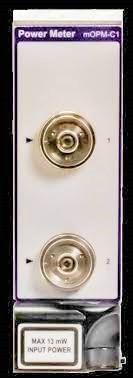
|
|
The JDSU mOPM-C1 (multiple application platform optical power meter module) is a third-generation power meter that brings a range of panel-mount and remote-head configurations to the Viavi Solutions MAP-200 platform. The MAP Optical Power Meter (mOPM-C1) module extends the optical power measurement capability of the MAP series by offering four grades of optical performance in panel-mount or remote-head configurations with 1, 2, or 4 inputs per module. Designed with 4 unique performance ranges, versions are available for all applications. Models with 110dBm dynamic range are complimented by versions that support 26dBm input power. The mOPM can be used for numerous applications such as measuring DUT settling time, cross talk, rise and fall times. It can also be used to measure synchronization and insertion loss stability. Also, allows for performance comparison (for example, comparing sequential switching to random switching).
Features and Benefits.
Panel-mount or remote-head configuration.
Single-, dual-, or quad-channel configurations available.
Compatible with single-mode and multimode fiber.
Ability to store up to 100,000 data points per channel.
All four performance grades are based on indium gallium arsenide (InGaAs) detectors and are suitable for applications using singlemode (SM) or multimode (MM) fiber. The response of the detector varies with the wavelength of the incident light.
Specifications.
Maximum Input Power: 27 dBm.
Operating Wavelength Range: 750 to 1700 nm.
Sampling Rate: 250 kHz.
Dynamic Range: 110 dB.
Compliance: CE, CSA/UL/IEC61010-1, and LXI Class C requirements (when installed in a MAP chassis).
Options and Configurations.
The mOPM-C1 is available in four detector types in 1,2 or 4 detectors per cassette. It is also offered in cassette mounted or remote detector option.
Detector type:
2mm InGaAs General Purpose.
Measures power levels from -70 to +11 dBm over the wavelength range of 800 to 1650 nm.
Features high accuracy, very linear behavior and low relative uncertainty due to polarization.
3mm InGaAs Premium performance.
Measures power levels from -80 to +11 dBm over the wavelength range of 750 to 1700 nm.
Features high accuracy, very linear behavior and extremely low relative uncertainty due to polarization.
3mm InGaAs Ultra performance.
Measures power levels from -110 to +11 dBm over the wavelength range of 750 to 1700 nm.
In addition to the features of the Premium Performance detector, the Ultra Performance detector offers excellent stability for long term measurement of extremely low optical power levels.
Filtered 2mm InGaAs High power.
Measures power levels from -45 to +27 dBm over the wavelength range of 800 to 1650 nm.
Features high accuracy as well as very linear behavior.
|